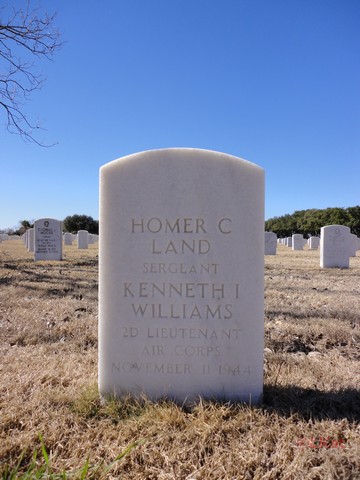Homer Clare Land was born on May 14, 1923 in Springhill, Kansas. He was the son of Frank Andrew Land and Ada Pearl Hoover Land. He served in the 553rd Bomber Squadron, 386th Bomber Group, Medium, as a Sergeant and Mechanic/Machine Gunner of the B26 #43-34370 AN*D, 2Lt Williams crew, during World War II.
On November 11, 1944, their plane took off from airfield A-60 in Persan-Beaumont, France on a mission to bomb the Communication Center at Putzlohn, Germany. The lead flight only had three planes, which were being led by Captain Liston of the 552nd Bomb Squadron. A plane flying in the low flight, number three position was in the process of maneuvering into the formation at 4,000 feet; when it got too close to the lead plane. At that moment Lieutenant Chester Douglas flying behind and a bit below in number six position - called on his radio to warn the number three position pilot that he was flying too close to the lead ship!
Wingtip vortices (circulatory motion of air about an airfoil - oftentimes simply referred to as prop wash) from the lead plane in the low flight destroyed the lift over the right-wing of the errant plane. Thus causing it to whip over upside down and back over the top of the number six plane flown by Lieutenant Douglas. At that point, Lieutenant Dick Cummings in number five position directly across from Lieutenant Douglas dumped his ship out of formation down to the right side of the flight.
In a flash, the doomed plane entered into a violent spin behind the number four plane in the space where seconds before the number five and number six ships had been flying. Lieutenant Williams's plane crashed and exploded at 1105 hours while carrying thirty 100-pound demolition bombs, along with 5,000 rounds of fifty-caliber ammunition, and approximately 950gallons of high-test aviation fuel. The crash site was in the vicinity of west of Rantigny, and south of Bois de la Sablonniere, France. The entire fight crew was killed! A witness by the name of, Jean Hugo recalled, “There were many people outside due to the November 11th, 1918 commemoration ceremonies concerning the end of World War One. We heard a very loud noise, like an explosion. The plane crashed south of Bois de la Sablonniere, it was full of bombs, all crew killed!”
During the mission interrogation process, Lieutenant Cummings mentioned that he could see Lieutenant Williams's wings wobbling, the ship reared up nearly colliding into other planes in the flight. He also heard a pilot call on the radio to Lieutenant Williams warning him about flying too close! Lieutenant Cummings further stated that it was believed the pilot probably had more pilot time than any other pilot in the squadron; due to the fact that he had been a flight instructor in the U.S, teaching cadets advanced flying techniques before joining the 386th Bomb Group. However, he was woefully inexperienced in Martin B-26 formation flying. Another fact was learned during interrogation, Lieutenant Williams was heard to remark to a crewmember, ”I’m not sure I am ready for this!” It was his first mission as a pilot in command, some eight minutes into the flight; he and his crew were dead!
Sgt Land is now buried in the Fort Sam Houston National Cemetery, San Antonio, Bexar County, Texas, USA, in the same grave with 2Lt Williams.
B26 #43-34370 aircrew:
2Lt Kenneth I. Williams - Pilot
2Lt Leo A. Kehn - Co-Pilot
F/O Glenn H. Tiger - Bombardier/Navigator
Sgt Donald E. Kelly - Machine Gunner
Sgt Homer C. Land - Mechanic/Machine Gunner
Sgt Hubert G. Misner - Radio Operator/Machine Gunner
Source of information: www.findagrave.com, francecrashes39-45.net, b26.com

